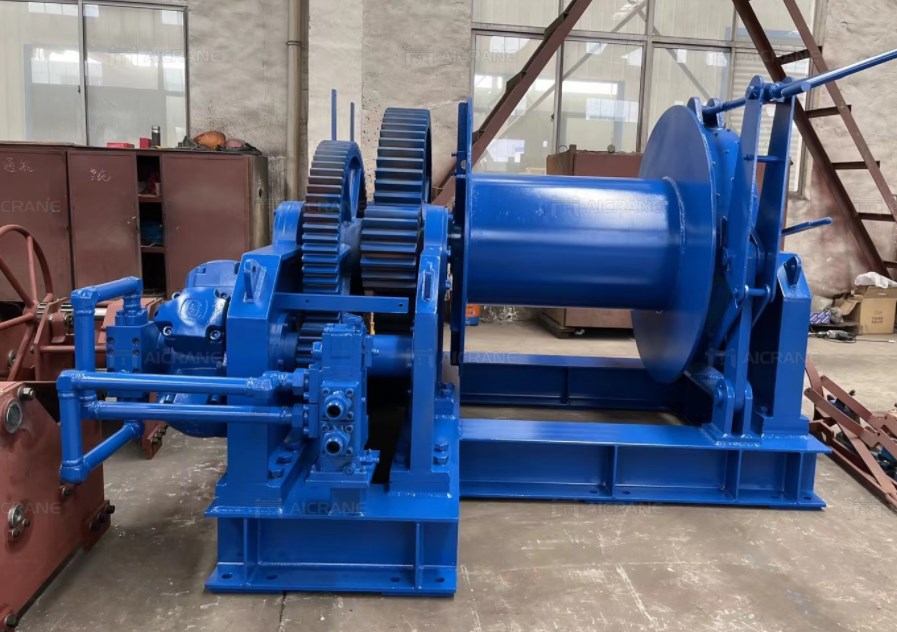A Comprehensive Guide to Maintaining a Hydraulic Marine Winch
Marine winches are integral components of vessels, facilitating various critical operations, including anchor handling, towing, mooring, and cargo handling. Hydraulic marine winches, in particular, are renowned for their reliability and robustness. However, like all machinery, they require regular maintenance to operate at peak efficiency and ensure safety at sea. In this comprehensive guide, we will explore the essential steps and best practices for maintaining a hydraulic marine winch, helping shipowners and operators keep their equipment in optimal condition.
Why Maintenance Matters
Proper maintenance of a hydraulic marine winch system is essential for several reasons:
Safety: Well-maintained winches are less likely to fail during critical operations, reducing the risk of accidents and injuries.
Efficiency: Regular maintenance ensures that the winch operates at maximum efficiency, saving time and resources during operations.
Cost Savings: Preventive maintenance is more cost-effective than addressing breakdowns, which can lead to expensive repairs and downtime.
Compliance: Many maritime regulations require vessels to have well-maintained equipment to ensure safety and environmental protection.
Basic Maintenance Steps for Hydraulic Marine Winches
Inspection and Lubrication
Regular visual inspections of the winch are crucial. Check for signs of wear, corrosion, or damage on all components, including the winch drum, cables, hydraulic hoses, and fittings. Lubrication is essential for maintaining the winch's moving parts. Follow the manufacturer's recommendations for lubrication intervals and use the appropriate lubricants.
Tension Control
Ensure proper tension control during winching operations. Over-tensioning can damage the winch and cables, while insufficient tension can result in poor performance. Monitor and adjust tension as needed, following the manufacturer's guidelines.
Cable Inspection and Replacement
The winch's cables are subjected to heavy wear and tear. Regularly inspect the cables for signs of fraying, kinks, or broken strands. Damaged cables should be replaced promptly to avoid accidents.
Hydraulic System Maintenance
Hydraulic marine winches rely on a hydraulic system for power. Check the hydraulic fluid level regularly and replace it as needed to maintain optimal performance. Ensure that hydraulic hoses and connections are in good condition and free from leaks.
Brake Inspection
The winch's braking system is critical for safety. Regularly inspect the brakes to ensure they are functioning correctly. Adjust or replace brake components as needed to maintain their effectiveness.
Control System Check
The control system is essential for the winch's operation. Test all control functions, including the direction of rotation, speed, and emergency stop, to ensure they are working correctly. Repair or replace any malfunctioning control components promptly.
Electrical System Inspection
If the winch incorporates electrical components, inspect the electrical system for signs of wear, corrosion, or loose connections. Ensure that electrical components, such as switches and wiring, are functioning correctly.
Seal and Gasket Maintenance
Check the winch's seals and gaskets for signs of damage or deterioration. Leaking seals can lead to contamination of the hydraulic system, which can result in extensive damage. Replace seals and gaskets as needed.
Cleaning and Corrosion Prevention
Saltwater and exposure to the marine environment can accelerate corrosion. Regularly clean the winch and apply anti-corrosion coatings or protective paint to exposed metal surfaces. This helps extend the winch's lifespan and maintain its appearance.
Documentation and Records
Maintain detailed records of all maintenance activities, including inspections, repairs, and component replacements. These records can be invaluable for tracking the winch's history and identifying potential issues.
Professional Inspection and Service
While regular maintenance can address many issues, it's essential to schedule periodic professional inspections and servicing by qualified technicians. These experts can identify potential problems that may not be apparent during routine inspections.
Best Practices for Hydraulic Marine Winch Maintenance
Follow Manufacturer's Guidelines: Always refer to the manufacturer's maintenance instructions and recommendations specific to your hydraulic marine winch. These guidelines are tailored to the equipment's design and requirements.
Regularity Matters: Establish a maintenance schedule and stick to it. Regular, routine maintenance is more effective than sporadic efforts.
Training: Ensure that personnel responsible for winch maintenance are adequately trained and familiar with the equipment. Training can prevent mishandling and damage during maintenance procedures.
Use Genuine Parts: When replacing components or parts, use genuine parts recommended by the manufacturer. Generic or substandard components may compromise the winch's performance and safety.
Safety Precautions: Prioritize safety during maintenance activities. Use appropriate personal protective equipment (PPE), follow lockout/tagout procedures, and take precautions to prevent accidents.
Environmental Considerations: Be mindful of environmental regulations when disposing of hydraulic fluids and other waste materials. Dispose of hazardous materials properly and in compliance with local regulations.
Emergency Preparedness: Have contingency plans in place for addressing unexpected breakdowns or emergencies. Being prepared can minimize downtime and prevent further damage.
Conclusion
A well-maintained hydraulic marine winch is essential for the safe and efficient operation of vessels in the maritime industry. By following a comprehensive maintenance regimen, adhering to manufacturer guidelines, and emphasizing safety, shipowners and operators can extend the life of their winches, reduce operational risks, and ensure compliance with industry regulations. Regular maintenance is an investment in safety, efficiency, and the longevity of valuable equipment on board marine vessels.



Comments
Post a Comment